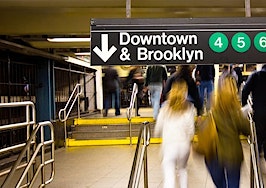- Bedford Avenue, between Grand Avenue and North 12th Street featured the highest average asking rent for ground floor retail space at $361 per square foot in the first quarter of 2016.
- North Brooklyn saw the largest jump on North 6th Street, between Driggs Avenue and Kent Avenue, at 4.8 percent, where retail rents reached $218 per square foot.
- Court Street and Smith Street, between Atlantic Avenue and Carroll Street both increased between the summer and winter seasons.
- As the L train construction start date looms, retailers moving to Brooklyn could prove beneficial as locals anticipate an upcoming struggle in outbound public transportation.
Brooklyn’s retail asking prices continue to grow throughout the top tier corridors in the borough, according to REBNY’s Winter 2016 Brooklyn retail report. Average rents held strong asking prices, with 14 out of 15 major corridors illustrating slight upswings from the third quarter of last year.
“The modest rise in asking rents from last summer to this winter speaks to the sustained strengthening of the retail market in Brooklyn,” said John H. Banks, III, president of REBNY.
[Tweet “Williamsburg featured the highest average asking rent for ground floor retail space”]
Williamsburg — more specifically, Bedford Avenue, between Grand Avenue and North 12th Street — featured the highest average asking rent for ground floor retail space at $361 per square foot in the first quarter of 2016. This corridor showed a 3.9 percent increase from the last findings in Summer 2015.
[graphiq id=”lxLmL4CdJpH” title=”Northern Brooklyn Brooklyn, NY Profile” width=”600″ height=”591″ url=”https://w.graphiq.com/w/lxLmL4CdJpH” link=”http://places.findthehome.com/l/140978/Northern-Brooklyn-Brooklyn-NY” link_text=”Northern Brooklyn Brooklyn, NY Profile | FindTheHome”]
North Brooklyn saw the largest jump on North Sixth Street, between Driggs Avenue and Kent Avenue, at 4.8 percent, where retail rents reached $218 per square foot.
While Brooklyn Heights — specifically Montague Street, between Hicks Street and Cadman Plaza — revealed a 26 percent increase between reports to reach $188 per square foot, REBNY disclosed the sample size was relatively small. The uptick was therefore more representative of the corridor’s value, and not representative of a major market shift.
Cobble Hill average asking prices — on Court Street and Smith Street, between Atlantic Avenue and Carroll Street — both increased between the summer and winter seasons. The average asking rent went up 7.8 percent to hit $175 per square foot on Court Street. Meanwhile, on Smith Street, prices rose 15.1 percent at an average $139 per square foot.
In Park Slope, retail rents on Seventh Avenue, between Union Street and Ninth Street, reached $96 per square foot, which is an 11.4 percent increase from Summer 2015. The second corridor in Park Slope — Fifth Avenue, between Union Street and Ninth Street — shifted upward almost 5 percent to reach an average $85 per square foot.
Keep in mind, important factors such as street/avenue frontage, ceiling height, below and above grade space and location factors traditionally affect rental value of properties. Lack of availability in corridors also allows high quality spaces to largely affect average and median asking prices.
Further, as REBNY notes, smaller corridors often prompt retailers to look toward adjacent blocks for more options. REBNY only surveys the top 15 corridors, and the rents on side streets may lease for considerably less than the locations profiled in data represented above.
Nonetheless, Brooklyn has been broadly recognized as a focus for retailers and commercial space overall, especially given its popularity with millennial renters.
As the L train construction start date looms, retailers moving to Brooklyn could prove beneficial as locals anticipate an upcoming struggle in outbound public transportation. More demand in the retail space could, however, push prices up even higher.
“The retail corridors examined continue to experience heightened activity, and we look forward to informing the retail community about the growth in Brooklyn as we continue to track the market activity in these corridors,” Banks said.





